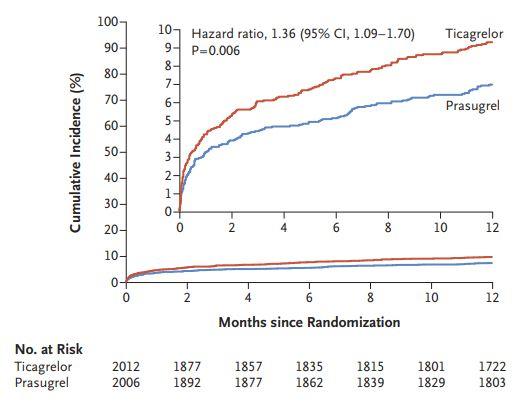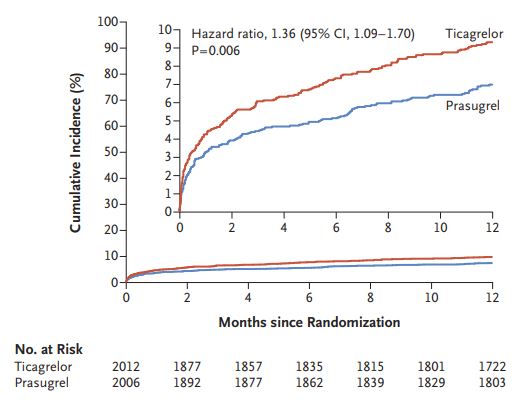Ticagrelor or prasugrel in patients with acute coronary syndromes - ISAR-REACT 5
Selected in NEJM by M. Hadid , R. Didier
The objective of the Intracoronary Stenting and Antithrombotic Regimen: Rapid Early Action for Coronary Treatment (ISAR-REACT) 5 trial is to test the hypothesis that the ticagrelor strategy is superior to prasugrel strategy in patients with ACS in a composite clinical outcomes.
References
Authors
Schüpke S, Neumann FJ, Menichelli M, Mayer K, Bernlochner I, Wöhrle J, Richardt G, Liebetrau C, Witzenbichler B, Antoniucci D, Akin I, Bott-Flügel L, Fischer M, Landmesser U, Katus HA, Sibbing D, Seyfarth M, Janisch M, Boncompagni D, Hilz R, Rottbauer W, Okrojek R, Möllmann H, M.D.,Hochholzer W, Migliorini A, Cassese S, Mollo P,Xhepa E, Kufner S, Strehle A, Leggewie S, Abdelhakim Allali A, Ndrepepa G, Schühlen H, Angiolillo DJ, Hamm CW, Hapfelmeier A, Tölg R, Trenk D,Schunkert H, Laugwitz KL and Kastrati A.
Reference
N Engl J Med 2019; 381:1524-1534
Published
17 October 2019
Link
Read the abstractReviewers
Our Comment
Why this study? – the rationale/objective
Ticagrelor and prasugrel have faster and stronger platelet inhibition as compared to clopidogrel. Both have demonstrated their superiority over clopidogrel in patients with acute coronary syndrome presentation (ACS) in two large randomized trials. According to the latter, the European guidelines now recommend the use of dual antiplatelet therapy (prasugrel or ticagrelor) as first-line choice for post-interventional treatment of patients with ACS. However, the timing of the initial loading dose could differ between prasugrel and ticagrelor in ACS patients, especially in NSTEMI patients. The pre-treatment with ticagrelor in NSTEMI could be given before the angiography, while prasugrel is administered only after visualization of the coronary anatomy, since no advantage has been observed when prasugrel is used as pre-treatment.
The objective of the Intracoronary Stenting and Antithrombotic Regimen: Rapid Early Action for Coronary Treatment (ISAR-REACT) 5 trial is to test the hypothesis that the ticagrelor strategy is superior to prasugrel strategy in patients with ACS in a composite clinical outcomes (death, myocardial infarction, stroke).
How was it executed? – the methodology
ISAR-REACT 5 is a multicenter, randomized; open-label trial. Assigned patients were eligible for enrollment in the trial if they were hospitalized for an ACS (ST-segment elevation myocardial infarction [STEMI], non–ST-elevation myocardial infarction [NSTEMI], or unstable angina) for which invasive evaluation was planned.
Patients have been randomized 1-to-1 in two different strategies:
- Strategy with ticagrelor (PLATO strategy): the patients received a loading dose as soon as possible after randomization of 180 mg and continued at a maintenance dose of 90 mg twice daily.
- Strategy with prasugrel (TRITON strategy): the patients received a loading dose of 60 mg and continued at a maintenance dose of 10 mg once per day. A reduced dose of 5 mg daily was recommended in patients who were ≥75 years old and in those who had a bodyweight of less than 60 kg. The timing to start the prasugrel depended of the clinical presentation, as soon as possible in patient with STEMI and after the angiography with NSTEMI.
The primary endpoint of the study was a composite of death, myocardial infarction or stroke at 12 months.
The secondary endpoints of the study were threefold:
- Safety endpoint: the incidence of bleeding at 12 months (Class 3-5 of BARC classification as defined by the Bleeding Academic Research Consortium).
- The rate of each components of the primary endpoint at 12 months
- The rate of stent thrombosis at 12 months
What is the main result?
Overall, 4018 patients were included between September 2013 and February 2018 in 23 centers (21 in Germany and 2 in Italy), with 2012 patients were assigned to ticagrelor strategy and 2006 patients were assigned to prasugrel strategy. The population included 41.1% of patients with STEMI and 46.2% of patients with NSTEMI and 12.7% of patients with unstable angina. Regarding the procedural characteristics, 84% of patients underwent PCI, 2% underwent CABG and 14% underwent medical management alone.
After 1-year follow-up, the rate of the composite primary endpoint was higher in the ticagrelor group as compared to the prasugrel group (9.1% vs. 6.8%, p=0.006, respectively; Absolute risk reduction 2.3% in favor to prasugrel). This difference among the 2 groups was mainly related to myocardial infarction reduction in the Prasugrel group. There was no significant difference regarding the incidence of all-cause death (HR 1.23; IC 95%: 0.91-1.68) or for stroke (HR: 1.17; 95% CI: 0.63-2.15). Moreover, the incidence of major bleeding events did not differ between the prasugrel group (4.8%) and the ticagrelor group (5.4%) (HR: 1.12, IC95% : 0.83-1.51; p= 0.46). The results were consistent among the sub-groups of clinical presentation (STEMI, NTEMI or Unstable angina).
Critical reading and the relevance for clinical practice
ISAR REACT 5 is the first large academic trial comparing prasugrel and ticagrelor strategies in patients with ACS. The results of the present trail were unexpected, since the study design was to test on a composite endpoint the superiority of the ticagrelor as compared to the prasugrel.
This trial has some relevant limitation such the fact that the study was carried out in open and that most of the follow-up was collected by phone call.
Although that these resultants should be confirmed by other trials, this study provides new elements, concerning the management of acute coronary syndrome, suggesting that the TRITION strategy could be better as compared to the PLATO strategy, regardless the initial acute clinical presentation (has STEMI, NSTEMI or unstable angina).
Finally, to transfer these results in the clinical daily practice, the strategy should be carefully followed, in particular with regard to pretreatment. In fact, the Prasugrel should be administered only after having obtained information on coronary anatomy, and using a lower dose in patients who were ≥ 75 year old or had a bodyweight of ≤ 60 kg.

Composite end-point at one year






No comments yet!